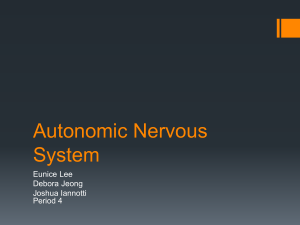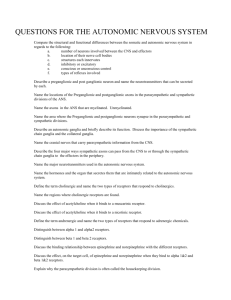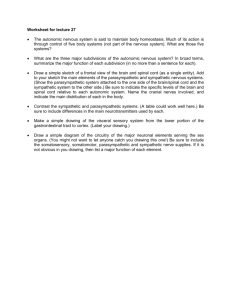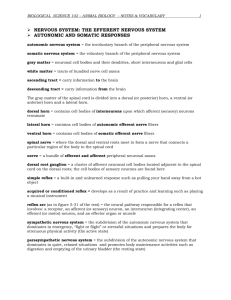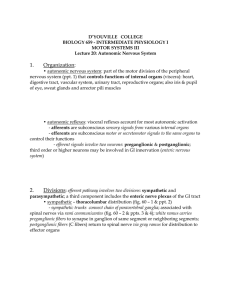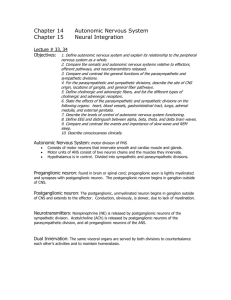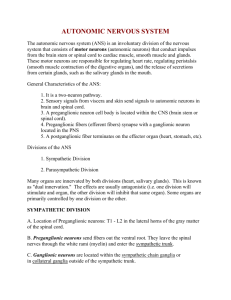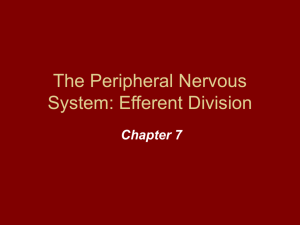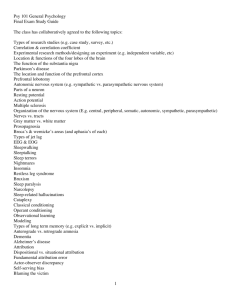Anatomy and Physiology I
advertisement
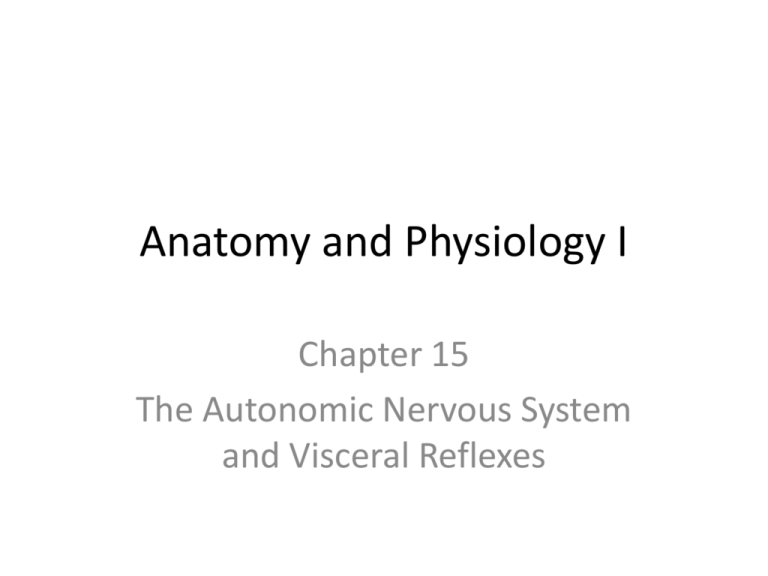
Anatomy and Physiology I Chapter 15 The Autonomic Nervous System and Visceral Reflexes Autonomic Nervous System (ANS) • Motor nervous system that controls glands, cardiac muscle, and smooth muscle (visceral motor) – Viscera of thoracic and abdominopelvic cavities – Blood vessels – Sweat glands – Piloerector muscles • Involuntary • Homeostasis Visceral Reflexes • Unconscious, automatic, stereotyped responses to stimuli • Slower responses- visceral receptors and effectors • Visceral reflex arc – – – – – Receptors Afferent neurons- to CNS Interneurons Efferent neurons- away from CNS Effectors ANS divisions • 2 subdivisions – Sympathetic – Parasympathetic • Often innervate same organ • Cooperative or contrasting effects • Autonomic tone- balance b/t divisions – Both systems are active simultaneously – Shifts in accordance to body’s changing needs Sympathetic • Adapts body for physical activity • Fight or flight • Subtle effects Parasympathetic • Calming effect on functions • Reduced energy expenditure and normal bodily maintenance Neural Pathways • Signal passes across 2 neurons to get to target organ • Cross synapse – Autonomic ganglion • Preganglionic neuron – Soma in CNS – Axon terminates in ganglion • Postganglionic neuron – Axon extends to target cells The Sympathetic Division • Thoracic and lumbar regions • Short preganglionic fibers – Myelinated – Spinal nerve to ganglion • Long postganglionic fibers – Unmyelinated – Ganglion to target organ The Parasympathetic Division • Brain and sacral regions • Long preganglionic fibers – Brain to ganglion – Almost to target cells • Short postganglionic fibers – Ganglion to target cell Neurotransmitters and Receptors • ANS division has contrasting effects • Sympathetic and Parasympathetic fibers secrete different neurotransmitters • Target cells respond in different ways – Depends of type of receptor Neurotransmitters • All autonomic nerve fibers either secrete ACh or norepinepherine – ACh- secreted by preganglionic neurons of both divisions and postganglionic neurons of the parasympathetic division – NE- secreted by all sympathetic postganglionic neurons • Sympathetic effects lasts longer – Ach secreted by parasympathic- quickly broke down by AChE Dual Innervation • Viscera receive nerve fibers from both sympathetic and parasympathetic divisions – Antagonist or cooperative effects • Antagonist effects- oppose each other • Cooperative effects- 2 divisions act on different effectors to produce unified overall effect Control w/out Dual Innervation • Dual innervation is not always necessary to produce opposite effects on an organ – Regulation of BP and blood flow – Sympathetic fibers keep vessels in partial constriction- vasomotor tone • Increase firing rate- constricts vessel – Smooth muscle contracts • Decrease firing rate- dilates vessel – Smooth muscle relaxes • Sympathetic division can shift blood flow from organ to organ according to body’s needs

